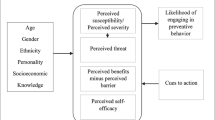Abstract
Ecopharmacovigilance (EPV) is now a well-accepted critical component for the control of potential environmental risk posed by pharmaceutical residues. And improving the knowledge and perceptions about EPV, especially among pharmacy professionals, is the first step towards addressing the environmental impact of pharmaceuticals. This cross-sectional study was conducted to assess the knowledge, perceptions, and practice on EPV using a validated self-administered questionnaire delivered to a sample of 120 pharmacy professionals in Hubei Province, China. And 107 usable survey instruments were acquired. The mean score for knowledge about EPV was 3.85 out of a total of 10. The pharmacy professionals’ overall perceptions of EPV and pharmaceutical pollution in environment were positive. But of the 107 respondents, 45 (42%) stated that they had not participated in any EPV measure. In addition, none had received training on EPV, and only 25 (23%) respondents had read the literature on EPV. In response to the question about the major perceived barrier to the effective implementation of EPV in China, 45 (42%) respondents chose the answer “poor awareness of EPV.” These data suggests most pharmacy professionals in China had a positive attitude but lack of knowledge and practices towards EPV. Therefore, more should be done to enhance pharmacy professionals’ knowledge on EPV.
Similar content being viewed by others
References
Bu, Q., Wang, B., Huang, J., Deng, S., & Yu, G. (2013). Pharmaceuticals and personal care products in the aquatic environment in China: a review. Journal of Hazardous Materials, 262, 189–211.
Chen, M., Qian, X., & Zhang, L. (2015). Public participation in environmental management in China: status quo and mode innovation. Environmental Management, 55(3), 523–535.
He, B., Wang, J., Liu, J., & Hu, X. (2017). Eco-pharmacovigilance of non-steroidal anti-inflammatory drugs: Necessity and opportunities. Chemosphere, 181, 178–189.
Holm, G., Snape, J. R., Murray-Smith, R., Talbot, J., Taylor, D., & Sörme, P. (2013). Implementing ecopharmacovigilance in practice: challenges and potential opportunities. Drug Safety, 36(7), 533–546.
Kot-Wasik, A., Jakimska, A., & Śliwka-Kaszyńska, M. (2016). Occurrence and seasonal variations of 25 pharmaceutical residues in wastewater and drinking water treatment plants. Environmental Monitoring and Assessment., 188(12), 661.
Kümmerer, K. (2009). The presence of pharmaceuticals in the environment due to human use--present knowledge and future challenges. Journal of Environmental Management, 90(8), 2354–2366.
Küster, A., & Adler, N. (2014). Pharmaceuticals in the environment: scientific evidence of risks and its regulation. Philosophical Transactions of the Royal Society B- Biological Sciences, 369(1656), 20130587. https://doi.org/10.1098/rstb.2013.0569
Kvarnryda, M., Grabicb, R., Brandta, I., & Berg, C. (2011). Early life progestin exposure causes arrested oocyte development, oviductal agenesis and sterility in adult Xenopus tropicalis frogs. Aquatic Toxicology, 103(1–2), 18–24.
Prakasam, A., Nidamanuri, A., & Kumar, S. (2012). Knowledge, perception and practice of pharmacovigilance among community pharmacists in South India. Pharmacy Practice (Granada), 10(4), 222–226.
Qiu, L., Dong, Z., Sun, H., Li, H., & Chang, C. C. (2016). Emerging pollutants part I: Occurrence, fate and transport. Water Environment Research, 88(10), 1855–1875.
Rocha, M. J., Cruzeiro, C., Reis, M., Pardal, M. Â., & Rocha, E. (2016). Pollution by oestrogenic endocrine disruptors and β-sitosterol in a south-western European river (Mira, Portugal). Environmental Monitoring and Assessment., 188(4), 240.
Silva, L. J., Lino, C. M., Meisel, L. M., & Pena, A. (2012). Selective serotonin re-uptake inhibitors (SSRIs) in the aquatic environment: an ecopharmacovigilance approach. Science of the Total Environment, 437, 185–195.
Umuhire, M. L., & Fang, Q. (2016). Method and application of ocean environmental awareness measurement: Lessons learnt from university students of China. Marine Pollution Bulletin, 102(2), 289–294.
Wang, J., & Hu, X. (2014). Ecopharmacovigilance: Current state, challenges, and opportunities in China. Indian Journal of Pharmacology, 46(1), 13–17.
Wang, J., He, B., & Hu, X. (2015). Human-use antibacterial residues in the natural environment of China: Implication for ecopharmacovigilance. Environmental Monitoring and Assessment, 187(6), 331.
Wang, J., He, B., Yan, D., & Hu, X. (2017). Implementing ecopharmacovigilance (EPV) from a pharmacy perspective: a focus on non-steroidal anti-inflammatory drugs. Science of the Total Environment, 603-604, 772–784.
Zhang, L., Wong, L. Y., He, Y., & Wong, I. C. (2014). Pharmacovigilance in China: current situation, successes and challenges. Drug Safety, 37(10), 765–770.
Acknowledgements
Funding of the study came from the National Natural Science Foundation of China (No. 81602108); and Humanities and Social Science Foundation from Hubei province ministry of education (No. 16Y023).
Author information
Authors and Affiliations
Corresponding author
Ethics declarations
Conflicts of interest
The authors declare no conflict of interest.
Rights and permissions
About this article
Cite this article
Liu, J., Wang, J. & Hu, Xm. Knowledge, perceptions, and practice of ecopharmacovigilance among pharmacy professionals in China. Environ Monit Assess 189, 552 (2017). https://doi.org/10.1007/s10661-017-6289-4
Received:
Accepted:
Published:
DOI: https://doi.org/10.1007/s10661-017-6289-4




